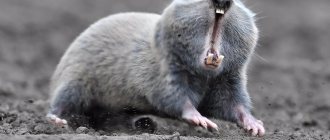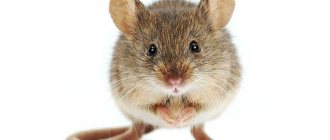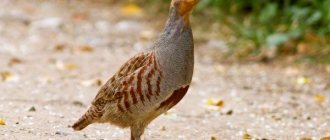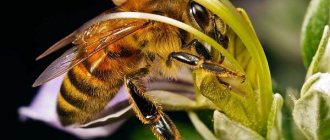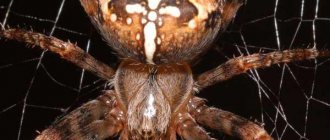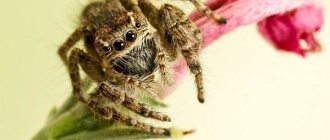- Wild animals
- >>
- Mammals
There are a lot of animals in nature that know how to dig tunnels underground. However, the most famous digger, known since childhood, is the mole . This mammal spends most of its life underground, which is facilitated by the special body structure and physical capabilities of the mole. This is a unique creation of nature, which brings both unconditional benefit and quite serious harm to humans.
What does a mole look like?
All members of the family are underground animals. They spend most of their lives underground and only occasionally appear on the surface.
The features of a mole’s adaptability to its environment are manifested in its appearance:
- The body shape of the animal is elongated, oblong;
- the paws are short, the hind legs are underdeveloped, the front ones are widened and slightly turned outward;
- the toes on the front paws are large, widely spaced and ending in strong flat claws;
- the head is small with a nose extended into a proboscis.
What sounds do moles make
? Due to constant exposure to darkness, the mole's eyes have been reduced. The eyeballs have completely lost the lens and retina. Some species of moles are able to distinguish light, but most members of the family are completely blind. The auricles are absent, hearing is poorly developed. The mole navigates and receives information using smell and touch. The most developed sense organs of a mole are the nose and the tail, which is equipped with sensitive hairs.
The entire body of the animal is covered with thick hair, and the pile easily lies in any direction, allowing the mole to move back and forth in narrow holes without turning around.
At the same time, the fitness of this species of mammals is not absolute, but relative. Thus, when it hits the ground surface, the features of the external structure of the mole lose their significance: the animals moving quickly underground become clumsy and clumsy, which makes them easy prey for predators.
What size is a mole
The length and weight of representatives of different mole species may differ:
| View | Weight | Height |
| Common mole | 70-100 gr | 12-16 cm |
| Altai mole | 150-200 gr | 17-20 cm |
| Himalayan mole | 50-60 gr | 10-13 cm |
| American shrew mole | 10 g | 6-7 cm |
Differences from other mammals
Some people are sure that moles and rodents are the same thing. However, this judgment is far from the truth. Moles have many differences from other rodents:
- Moles are not endowed with such powerful jaws as are characteristic of rodents, so they live where the soil is very loose. It's easy to make long passes with your paws.
- Rare rodents can swim, and the mole is an excellent swimmer. It will not be difficult for him to swim across a medium-width river.
- These shrews are completely unsuited for life on earth. When they accidentally land on the surface, their behavior seems clumsy, since they have almost no vision and are unable to adequately perceive the environment. On the ground they can only move by crawling.
- Moles are endowed with weak vision, designed to be able to distinguish light from dark. Therefore, with such characteristics, a mole ideally lives only underground.
The following characteristic features distinguish moles from small rodents:
- shortened black fur that is shiny;
- an elongated proboscis in the head, with nostrils at the bottom;
- rather large and widely spaced forelimbs of a spatulate type, the back of which faces upward;
- the hind legs are not large, they are poorly developed;
- small, visually impaired eyes;
- the length of the mole varies from 11 to 21 cm, and the body weight can be about 60-150 grams;
- shortened tail.
Types of moles
Below are descriptions of animals belonging to the most common mole species.
European
Found in Europe and Asia. The animal is of medium size and has a relatively short tail (2-3 cm). The coat color is dark gray, almost black, with the belly being noticeably lighter.
European moles breed once a year, the first coat of the young is light, later the color becomes dark.
Blind
The main difference from its relatives is the complete absence of eye holes. Individuals are medium-sized, covered with dark brown fur. The range extends to the Caucasus, northern and eastern regions of Turkey, and Iran.
Starburst
An inhabitant of North America and Canada with a rather unusual appearance. The animal is distinguished by its rather large size: body length - 20 cm, tail length - 7-8 cm. Unlike other moles, the animal has a stigma formed from many movable fleshy processes, reminiscent of the tentacles of a starfish.
Another feature of the starfish is the ability to move through the snow, swim, and dive under ice. In addition to the insects and worms familiar to moles, the starfish eats fish and shellfish caught in the water.
Caucasian
The name indicates the habitat of the animal. The Caucasian mole is of medium size, dark brown fur, and its tail reaches 3 cm in length.
Long-tailed
The animal is distinguished by its small body size (8-9 cm) and a relatively long tail, which can reach a length of 4-4.5 cm. It lives in eastern Asia: China, Vietnam.
Ussuri mogera
Unlike species that have underdeveloped eyes, the Ussuri mogera has no eyes at all. It is found in the Primorsky Territory of Russia, as well as in northeast China. This is the largest mole among all known species on the planet. Its length can reach 21 cm, and its weight is 300 grams.
Reproduction and offspring
The breeding process of moles is directly dependent on their habitat, although their rut begins at the end of March. Older females mate at earlier terms than younger ones. Interestingly, the mating process takes place not in burrows, but on the surface of the earth.
The female carries her future offspring from a month to 2 months, depending on the species, while in Siberian moles this period lasts for 9 months. At the end of April, moles begin to give birth to offspring that do not have fur, and besides, they are blind, although there is no need to talk about moles’ vision. Although these animals breed only once a year, up to 10 cubs are born. It is worth noting that the large Mogera reproduces 2 times a year. The offspring that are born grows by leaps and bounds and within a month reaches the size of adults. Basically, individuals become sexually mature after 1 year of life, although in some species this period begins much earlier.
Lifestyle
Moles lead a solitary lifestyle and can briefly interact with individuals of their own species only during the breeding season. The rest of the time they are characterized by quite aggressive behavior towards their relatives.
In order for his body temperature to be stable, he has to search for food almost all the time, taking short breaks to rest. This is due to the intense metabolism characteristic of all small warm-blooded animals. Digestion of food takes 3-4 hours, after which the animal is forced to go back in search of food. A long break in feeding (14-15 hours) can lead to the death of the animal.
How do they winter
There is a misconception that moles hibernate in winter. In fact, they continue to live their normal lives, showing relatively less activity than in the warm season.
What do they eat?
The diet of most varieties consists of earthworms, slugs, snails, insects and larvae that hide underground or in dead leaves. But starfish, in addition to their usual food, can feed on small fish, shellfish and other underwater creatures. And mogers supplement their menu with butterflies and caterpillars. In addition, many varieties include plant foods in their diet.
On average, moles feed 5 to 6 times a day.
After each meal, the animals curl up into a ball and fall asleep. Sleep lasts from 3 to 4 hours, the mole spends this time digesting food. In one meal, the animal eats about 20–30 g of worms and insects; per day, the amount of animals eaten can exceed 90–100 g. In the summer, the amount of food eaten increases, as the heat speeds up metabolism.
Moles have a high metabolism, so they must eat a new portion every 14–17 hours. If the animal does not find food, it may die of hunger.
After the mole catches the worm, it eats it whole or tears it into small pieces. But before eating, the animal always squeezes the earth out of the worm’s body.
Where do moles live
Various species of moles are found in North America and Eurasia. Their distribution area is limited to the temperate and subtropical climate zone.
Habitat
Suitable living conditions for moles are loose, moderately moist soil rich in nutrients. Most often, you can find signs of the presence of underground animals on the outskirts of the forest, in meadows, hills, and agricultural fields.
Moles do not settle in too wet swampy soils, rocky soil, or arid areas.
How deep in the ground do moles live?
Moles are constantly on the move and can make up to 50 m of new passages per day. In the occupied territory, animals build a whole multi-tiered system of burrows connected to each other for various purposes.
In loose soil, the mole moves at a depth of 5-10 cm, lifting the soil at the site of the tunnel construction. The depth of the passages in the soil that dries out from above reaches 50 cm. If it is necessary to build passages at great depths, the animal periodically digs vertical branches through which it throws out excess soil. Small earthen mounds are the main sign of the presence of an underground inhabitant on the site. The nest in which it rests between searches for food is located at a depth of 1.5-2 m.
From time to time, the animal makes the rounds of already dug feeding holes in search of prey that has fallen there, and also builds new passages.
How moles dig holes
Nutrition
These creatures belong to the order of insectivores, therefore, their diet corresponds to this. A soil animal, the mole mainly obtains food for itself in feeding passages, that is, underground tunnels dug by it, with the help of its nose, which perfectly distinguishes odors.
It eats slugs, beetle larvae, and earthworms. But these underground inhabitants also hunt when they come to the surface. There they catch beetles, ants, frogs, and small rodents. These animals, contrary to some unreliable rumors, do not consume plant food at all. The food metabolism of moles is quite intense, and they require approximately 150 g of animal food per day.
By the end of autumn, in preparation for the cold, such animals begin to make winter supplies for themselves, immobilizing their prey through a bite. Such pantries, usually located in close proximity to the nest, contain more than 2 kg of food.
How moles reproduce
Males and females reach sexual maturity by one year. Mole breeding usually occurs in early spring. The duration of gestation depends on the species: usually 1.5-2 months pass from the moment of mating to the appearance of the cubs.
There are from 5 to 10 cubs in one litter. For the first month, the female feeds the babies with milk. During this time, their teeth grow, claws appear, and their bald body becomes covered with hair. At the age of 1-1.5 months, moles begin to look for food on their own.
By 2 months, young moles become completely independent and begin to search for unoccupied territory and build a hole.
Population and species status
As a rule, moles live separately, regardless of gender, and protect their possessions, both males and females. Pairs are formed only for the mating period, after which the males leave the females and do not take any part in raising their offspring.
Important point! With the arrival of spring, males are engaged in increasing their controlled territories. There are 5-30 individuals per hectare of land, which depends both on the variety and on the habitat conditions.
The common mole has recently been considered as an object for fur trade, although this animal plays a very important role in maintaining the balance of the ecosystem of our Planet. Today, no one is engaged in this fishery, so the total number of moles depends on many natural factors that affect the reproduction process of these animals.
How to get rid of moles in your summer cottage once and for all
In gardens and vegetable gardens, where the soil is regularly watered and fertilized, there is always an abundance of earthworms - the main food for moles. It is not surprising that animals often settle in summer cottages and garden plots, creating inconvenience for their owners. In search of prey, moles dig tunnels, damaging the root system of plants. And despite the fact that a mole can destroy many pests (mole crickets, cockchafers, slugs, caterpillars), the harm from its activity is much greater than the benefit.
Very often, the fight against moles is carried out using inhumane methods. There are several ways that will allow you to expel animals from the site without causing them harm.
Grouse
- Planting plants that emit strong, repulsive odors. These include some flowers: marigolds, daffodils, hazel grouse. Valerian, garlic, and onion help get rid of moles. The disadvantage of this method is that the barrier will act as long as the roots of the unpleasant-smelling plants are in the ground.
- Putting rotten food in holes. To drive out moles, fresh molehills are torn up and rotten eggs, rotting fish or meat are placed in the opened passage. The top layer is covered with earth and compacted tightly. Animals do not tolerate the smell of kerosene, turpentine, or tar. You can pour a small amount of a sharp-smelling liquid into the hole and cover it with earth.
- Installation of sound repellers on the site. You can buy a ready-made device or make it yourself. The design consists of a metal pin that is driven into the ground and a device located at the top that produces sound. This could be, for example, a cut tin can or a plastic bottle with bent blades, or bells. The sounds generated by the wind are transmitted through the metal into the ground, scaring off moles.
A fence made of metal mesh, slate or other durable material will help prevent the appearance of underground animals. It is dug in to a depth of 50-60 cm along the entire perimeter of the site, with the upper edge protruding 30-40 cm above the ground.
Radical methods of controlling moles include the use of poisons, traps, and traps.
PLATYPUS
Lifestyle and habitat
To better understand what kind of animal a mole is , you should describe in detail the life of these interesting creatures. As is already clear, their existence takes place underground. But not all types of soil are suitable for them. Therefore, these representatives of the fauna prefer to inhabit damp areas with fairly loose soil.
On the other hand, they simply could not cope, because they spend their lives endlessly digging numerous underground networks of passages and labyrinths. People rarely see such animals, since moles are extremely rare on the surface.
However, sometimes you can see characteristic earthen mounds in fields and meadows. This is the result of the life activity of such creatures. After all, moles prefer to throw excess soil onto the surface.
Due to the unique nature of their existence, moles are included in the list of very dangerous and daring agricultural pests. Underground, they disturb crops and break plant roots. But we should not forget that at the same time the animals loosen the soil, from which the oxygen exchange in it is greatly activated, which promotes the vital activity of the same plants and beneficial microorganisms.
For moles there is not much difference: day on earth or night, which is not surprising, given their blindness and lifestyle. These animals have completely different biorhythms.
They stay awake for up to four hours, then rest, then again indulge in activity for a similar period of time. It should be noted that such animals are not able to sleep for more than three hours.
You can’t travel much underground, and therefore these animals don’t make large movements. The only exception is the unusually hot summer periods. At this time, moles tend to move closer to rivers and other fresh water bodies so that their bodies do not lack moisture.
The mole is not a social lover. And this applies to all living beings, and to relatives in particular. Such animals are inveterate loners, in addition, they are great owners. Each of them strives to take possession of an individual plot of land, the rights to which they certainly want to protect, and very zealously.
Moles are not known for their flexible nature. And sometimes they are extremely aggressive, and this applies not only to males, but also to the female half. To imagine the population density of moles, we note that on an area of 1 hectare, from several specimens of such animals to three dozen can settle.
If moles happen to be neighbors, they try not to intersect with each other. Each of the animals has its own underground passages, where they tend to stay, without maintaining relationships with their relatives. If these creatures accidentally collide, they try to disperse as quickly as possible without creating problems for themselves.
Although each of them in their hearts would gladly occupy the territory of the other. Therefore, if a neighbor dies, those living in the territories adjacent to him will find out about it quite quickly. And those of their moles that turn out to be quicker seize the vacant living space, but in some cases divide it between the applicants.
How do these animals distinguish occupied areas from free ones? These creatures leave marks on their properties, and the substance they secrete contains a very odorous secretion.
During winter periods, moles do not hibernate. They prepare for cold weather in a different way: they dig deep holes and accumulate fat and food reserves. Only underground are these animals safe. When they go outside, they become completely defenseless. Therefore, they can be successfully attacked by martens, eagle owls, foxes and other predators.
Interesting Facts
- Moles are capable of creating food reserves: the animal immobilizes the animals caught in excess of worms by biting off their heads and takes them to specially dug chambers.
- One of the forms of adaptation of moles to living underground is intersexuality of females. It has been established that they form so-called ovotesticles: ovaries containing testicular tissue. As a result, an increased amount of male hormones enters the blood of females, which make them stronger, more aggressive and capable of not only digging holes, but also defending their territory.
- The duration of gestation of offspring by a female Siberian mole is 289 days.
- Moles secrete a musky-smelling secretion to mark their territory and alert other members of their species to their presence. As soon as the mole dies and its smell weakens, the empty hole is occupied by one of its relatives.
Let's fight and destroy the moles
What is the most effective way to get rid of moles? In fact, there are a lot of them. The use of certain techniques depends on the specifics of the site and the ability to use certain means. By the way, not all types of destruction of these animals are humane.
Effectively getting rid of moles is a series of measures using chemicals. Traps and repellers are slightly less effective. There are also folk techniques that are quite helpful in getting rid of these pests.
Lifespan
In the wild, a mole lives from 2 to 5 years. The maturation period is only 2 months. Animals have extremely few enemies underground, so almost all the cubs survive. Unlike mice, female moles give birth to only one litter per season; pregnancy lasts 10 days longer. This feature allows females to maintain their own health; the birth of babies does not deprive her of vitality. The life expectancy of females does not differ from that of males. Natural enemies of young and adult moles are cats, dogs, foxes, wolves, and hedgehogs.
Starfish
Known under the names star-nosed mole, star-nosed mole, star-nosed mole, star-nosed mole. In appearance it is similar to most other moles, but differs in its elongated tail (6–8 cm) and hard fur that does not get wet. There are two skin growths on the face, similar in appearance to an asterisk, which is where the name of the individuals comes from. Animals in adulthood weigh up to 85 g. The eyes are small, but clearly distinguishable in appearance. Lives in the eastern regions of North America.
Western American
The body length of the animal is 11–14 cm, while the tail can take up to 5.5 cm. Body weight reaches 170 grams. The proboscis of the muzzle is moderately elongated. The eyes are small, hidden under the fur. There is no external auricle. The hand of the foot is very wide. The tail is thick, covered with sparse hairs. Distributed in North America.
A small species of the Mole family. Lives in China.
Long-tailed
Lives in Asia. Body length 7–9 cm, weight up to 12 grams. There are no auricles. The front legs are slightly widened and equipped with almost straight claws.
Distributed in the Chinese province of Sichuan. It lives mainly in forests of the temperate zone.
Caucasian
Outwardly, it almost completely resembles a European mole. It stands out only for its rudimentary eyes covered with thin skin. It has large teeth and velvety fur. It can burrow to a depth of 1 m. It eats up to 40 g of food per day.
Blind
The smallest mole in our country with a body length of 8–12 cm, weight – no more than 30 grams. The eyes are covered with thin skin. Tail length is about 3 cm.
Japanese mogera
It lives in the southern territories of Japan, as well as in China, Korea and the south of Primorsky Krai. Prefers to live in cultivated fields and meadows.
Description of the animal
Its cylindrical, shortened, dense body helps it move through dug tunnels. It is slightly pointed at the front and rounded at the back.
The front part is much better developed. The animal has 6 main species and 11 different varieties. They differ in the structure of the jaw, skeleton, their weight, and size.
Young individuals differ from older mammals in the silvery hue of their skin. The mole has practically no neck. The head seems pulled into the shoulders.
The body smoothly touches the triangular head. On the head there is a proboscis, along the edges of which there are vibrissae. Thanks to these sensitive hairs, the animal finds food.
The mole's forelimbs are wide, everted, and shaped like a shovel. Initially the paws are silver-black. Over time they begin to fade.
There are 5 tightly pressed toes on the feet. They are connected by thin membranes. The claws are elongated, strong, slightly flattened. They reach 10 mm in length.
The hind feet are unwebbed, but with very sharp, elongated claws. The animal has 44 teeth, 2 of which are well-developed upper canines. In adult moles, the fangs are severely worn out.
The size of a male mole from proboscis to tail can reach 115-200 mm, females - from 105 to 145 mm. The weight of males is 90-100 g, females - 60-80 g.
Plants that can drive moles out of the area
These options refer to folk methods of getting rid of mammalian pests, but they work no worse than poisons. A pungent and unpleasant odor for the mole is emitted by:
- Garlic.
- Onion.
- Daffodils.
- Marigold.
They should be planted closer to the mole holes. However, scientists have noticed that some individuals manage to push the hated “stinkers” out of their landing sites, thereby destroying them.
In such cases, it is worth trying to use products with essential oils that have a very strong smell. This is pine, lavender. Pieces of fabric are soaked in oil, which are then placed in the passages.
Often, site owners simply pour kerosene, ammonia or turpentine into holes. By the way, if there is a mousecat living in the house, you should “ask” him to retrain. You need to show him the hole in which the mole will move. The cat's instinct will do its job.
Number and economic importance
Moles are ubiquitous and are not a protected species. This is one of the few insectivores that was important as a fur-bearing species. Since the 19th century durable, velvety moleskins were mined in large quantities. Currently, for economic reasons, the mole has almost no commercial significance.
Moles bring benefits by exterminating harmful insects and changing the structure of the soil - loosening it and enriching it with organic matter. Long-term digging activity of moles leads to improved soil; Excess moisture goes through molehills to lower soil horizons. At the same time, the mole is considered a pest of agriculture, gardening and horticulture. Digging its passages, it damages the roots of plants, thereby disrupting their normal nutrition and often causing death. Moles also destroy earthworms that are beneficial to the soil. They fight moles with a wide variety of methods, including using pungent odors (by placing chopped onions, garlic, rags soaked in kerosene, etc.) or sound signals (turntables, reeds, ultrasonic devices, etc.) in the mole passages.

